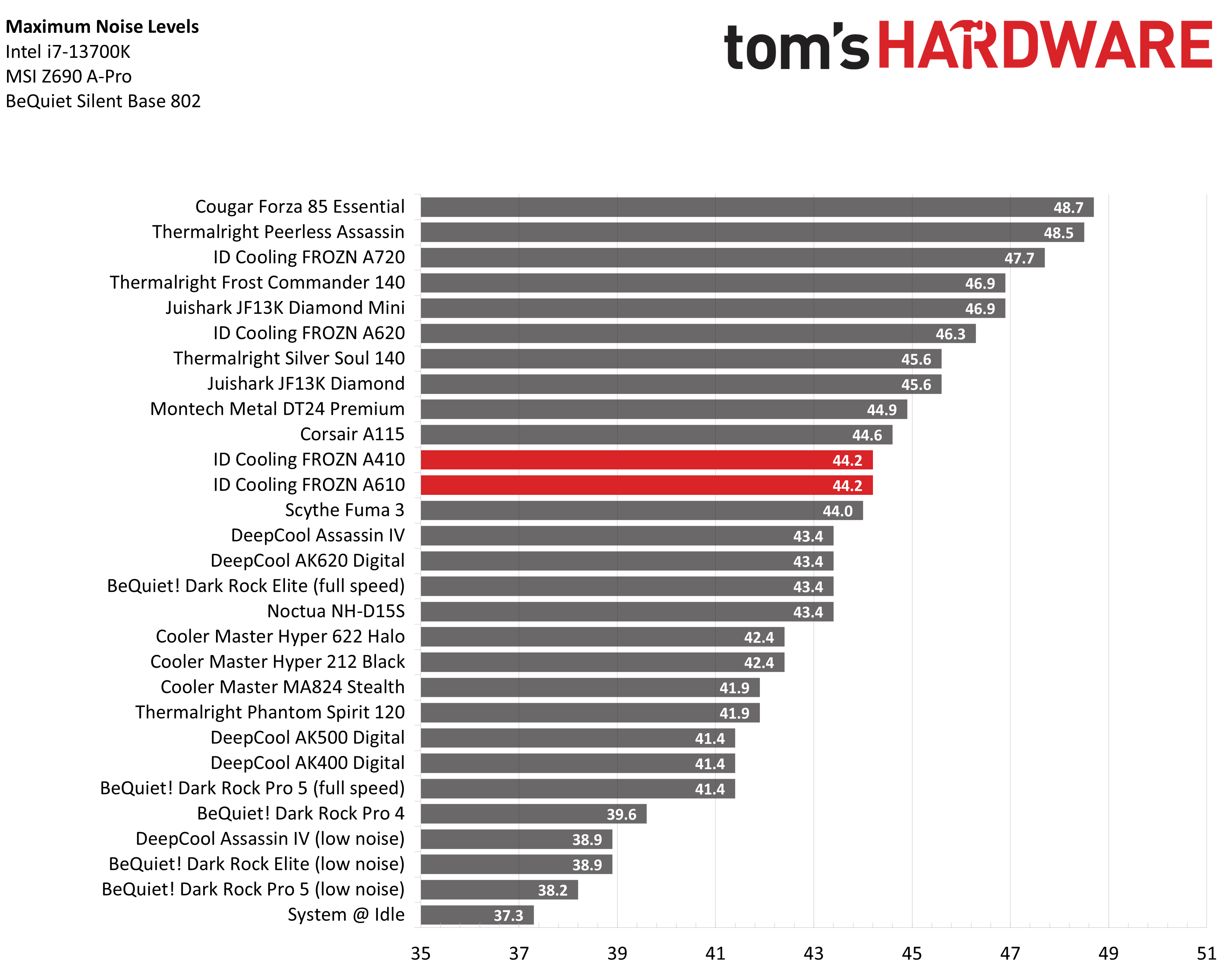Why you can trust Tom's Hardware
Thermal results without power limits
Without power limits enforced on Intel’s i7-13700K, the CPU will hit its peak temperature (TJ Max) and thermally throttle with even the strongest of air coolers. When the CPU reaches its peak temperature, I’ve measured the CPU package power to determine the maximum wattage cooled to best compare their performance. The results below do not include the best liquid coolers on the market, which can keep the CPU under TJ Max (100C).
ID-Cooling’s FROZN A410 and A610 aren’t expected to be chart toppers; they are basic single-tower CPU coolers intended to provide essential cooling performance for budget builds. The A410 performed reasonably well compared to other coolers of its class, better than Cooler Master’s latest revision of the Hyper 212 Black, but not quite as good as DeepCool’s AK400.
The A610 technically outperformed the A410, but its performance was worse than expected, only cooling a few watts more than the A410 model. I remounted the cooler to be sure, but these results were the same.
I brought these results to ID-Cooling and they confirmed that my results were within expectations. The reason there’s so little difference between the two models comes down to the CPU base – the A410 uses direct-touch heatpipes incorporated into the CPU block, which allows for more efficient thermal transfer compared to the standard nickel-plated copper CPU base included with the A610. There will be an improved model, the A610 EVO, released later this year to address this deficiency.
Both coolers utilize the same AF-125-K 120mm fan, and run at a maximum of 44.2 dBA. This is a moderate noise level and shouldn’t bother most users, but if you’re particular about noise levels you’ll want to implement a custom fan curve.
Thermal results with noise normalized to 38.2 dBA
Finding the right balance between fan noise levels and cooling performance is important. While running fans at full speed can improve cooling capacity to some extent, the benefits are limited and many users prefer a quiet system. With this noise-normalized test, I’ve set noise levels to 38.2 dba. This level of noise is a low volume level, but slightly audible to most people.
The A410 cooled 199W when set to low noise levels, equal to its competitor from Cooler Master, but 5W behind DeepCool’s AK400. The A610 model cooled an additional 4W, for a total of 203W, which is again a bit disappointing for a cooler of its size.
Get Tom's Hardware's best news and in-depth reviews, straight to your inbox.
175W Cinebench results
Most coolers on the market can keep Intel’s i7-13700K under its peak temperature if the power consumption is limited, so for this test, we’ll be looking at the CPU’s actual temperature.
With a steady 175W load run on the CPU, there was no difference in thermal performance between the A410 and A610 models. This is on par with slim single-tower coolers from Cooler Master and DeepCool, but better than some of the older-generation air coolers that I’ve included in my results.
As I test noise levels at 175W and 125W while tied to the default fan curve of my motherboard, noise levels were also the same between these two models – both running at a moderate 43.4 dBA.
125W Cinebench results
The lowest power limit I test with Raptor Lake CPUs is 125W. This is a high enough limit to allow the CPU to maintain its base clock speeds even in the most intensive tests, and most coolers should be capable of keeping the CPU below TJ Max (the max temperature before throttling) – even low-end coolers.
Thermals don’t really matter in this scenario, as even Intel’s stock cooler can handle a load like this with ease. Noise levels, rather than CPU temperature, are the most important factor here. That said, the A610 kept the CPU a single degree cooler than the A410 model, and as a result ran slightly quieter at 38.2 dBA, versus 38.9 dBA recorded for the A410 model.
Conclusion
ID-Cooling’s FROZN A410 model doesn’t break any thermal records, but that’s OK – this is a budget cooler intended to provide basic performance sufficient for most users. In that aspect, it performs well enough for $29.99 USD, and its noise levels are reasonable.
However, the A610 model is a lot harder to recommend to anyone. It doesn’t stand out from the A410 significantly enough to be worth considering it over the A410 model, and it’s $10 more expensive.

Albert Thomas is a contributor for Tom’s Hardware, primarily covering CPU cooling reviews.







